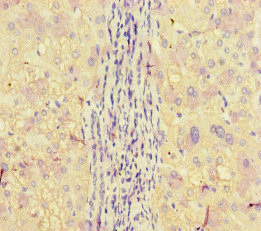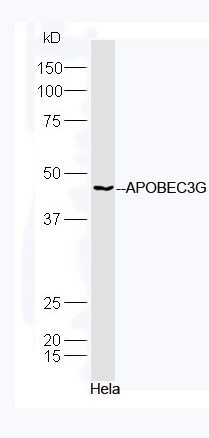
Immunohistochemistry of paraffin-embedded human liver tissue using CSB-PA001926LA01HU at dilution of 1:100
APOBEC3G Antibody
CSB-PA001926LA01HU
ApplicationsImmunoFluorescence, ELISA, ImmunoHistoChemistry
Product group Antibodies
ReactivityHuman
TargetAPOBEC3G
Overview
- SupplierCusabio
- Product NameAPOBEC3G Antibody
- Delivery Days Customer20
- ApplicationsImmunoFluorescence, ELISA, ImmunoHistoChemistry
- CertificationResearch Use Only
- ClonalityPolyclonal
- ConjugateUnconjugated
- Gene ID60489
- Target nameAPOBEC3G
- Target descriptionapolipoprotein B mRNA editing enzyme catalytic subunit 3G
- Target synonymsA3G, ARCD, ARP-9, ARP9, CEM-15, CEM15, MDS019, bK150C2.7, dJ494G10.1, DNA dC->dU-editing enzyme APOBEC-3G, APOBEC-related cytidine deaminase, APOBEC-related protein 9, DNA dC->dU editing enzyme, apolipoprotein B editing enzyme catalytic polypeptide-like 3G, apolipoprotein B mRNA editing enzyme cytidine deaminase, apolipoprotein B mRNA editing enzyme, catalytic polypeptide-like 3G, apolipoprotein B mRNA-editing enzyme catalytic polypeptide 3G, deoxycytidine deaminase, phorbolin-like protein MDS019
- HostRabbit
- IsotypeIgG
- Protein IDQ9HC16
- Protein NameDNA dC->dU-editing enzyme APOBEC-3G
- Scientific DescriptionDNA deaminase (cytidine deaminase) which acts as an inhibitor of retrovirus replication and retrotransposon mobility via deaminase-dependent and -independent mechanisms. Exhibits potent antiviral activity against vif-deficient HIV-1. After the penetration of retroviral nucleocapsids into target cells of infection and the initiation of reverse transcription, it can induce the conversion of cytosine to uracil in the minus-sense single-strand viral DNA, leading to G-to-A hypermutations in the subsequent plus-strand viral DNA. The resultant detrimental levels of mutations in the proviral genome, along with a deamination-independent mechanism that works prior to the proviral integration, together exert efficient antiretroviral effects in infected target cells. Selectively targets single-stranded DNA and does not deaminate double-stranded DNA or single-or double-stranded RNA. Exhibits antiviral activity also against simian immunodeficiency viruses (SIVs), hepatitis B virus (HBV), equine infectious anemia virus (EIAV), xenotropic MuLV-related virus (XMRV) and simian foamy virus (SFV). May inhibit the mobility of LTR and non-LTR retrotransposons.
- ReactivityHuman
- Storage Instruction-20°C or -80°C
- UNSPSC41116161








